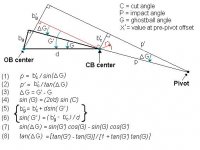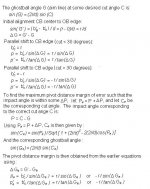Here is my video showing BHE with no "compensation".
http://www.youtube.com/watch?v=FLfyuAF7kNk
It is my contention that using backhand english one does not need to "compensate" i.e. move to a new space when using side spin.
When someone says "compensate" then this is what I understand; I understand that you mean to say that you must get up off the centerline of aim and reposition your body so that your aim is now to the right or left by x-distance based on your judgement of how much deflection there will be so that the cue ball will contact the object ball in the right spot to make the object ball go into the hole. Is this what you also think of when you say compensate?
If you use backhand english then you will find that you do NOT have to move your entire body to a new place when aiming with spin. ALL you need to do is move your backhand so that the tip pivots to the desired spin and shoot the shot.
The cue will be on the
EXACT SAME LINE as if you had moved your entire body.
That's the whole "trick" to BHE. There is no "magic" to it although it certainly feels that way.
If you have say six spin positions - HR, R, LR and the opposites, or better said 1-2 o'clock - 3 o'clock and 4-5 o'clock and their opposites then you have SIX different body movements to get to in order to "compensate" for deflection. However if you use BHE then the compensation is automatically built in as you don't have to move your feet. Instead you move your backhand a little bit and you're right on the right line.
Now of course you can go to far out on the ball and cause way too much deflection and still miss the ball but once you start using BHE you figure out pretty quickly where the tip has to be.
I welcome discussion from Stan and Dave as to whether they "compensate" as I defined compensation above when they use CTE. I don't. I use CTE (Or what I think is CTE) to line up and then I apply my spin using BHE.
I welcome anyone to put up a video that shows how to compensate (move your body) as defined above while also using BHE. I understand that Joe Tucker advocates front hand english, ie. moving the bridge slightly to the left or right in conjunction with BHE, "A little of both" as he puts it. I can see where this COULD work as well and might even be much better. I don't use FHE (not consciously) but maybe that "little bit of both" is part of it.
In any event BHE works. Watch the video and offer your critiques.
Disclaimer. I did miss a few shots because I was putting way too much spin on the ball and one time I just rushed into the shot and didn't aim it properly. Towards the end I miss some really thin cuts because I was starting to get ahead of myself and get into CTE plus BHE and I wasn't focused. So feel free to criticize the misses but understand that they don't invalidate BHE - rather they show that poor aim makes you miss - duh - and adding too much spin throws the cueball way off.
Maybe tomorrow I will have calmed down enough to be able to do the CTE/other systems video.




